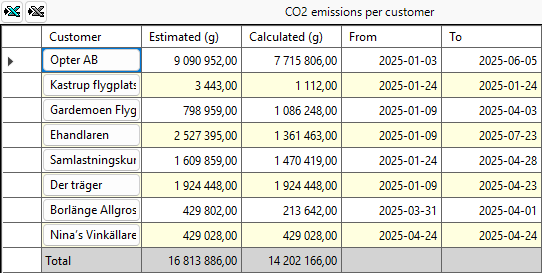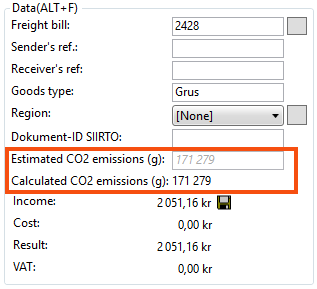Last updated: 2025-08-22
CO2 emissions in grams, overview
Valid Opter 2024.06.00 and later. Some functional improvements are available if you use Opter 2024.12.00 or later.
If you have Opter version 2024.06.00 or later, you can choose the following:
-
Whether the CO2 emissions calculation should take into account pricing weight.
-
How the consignment order's Calculated CO2 emissions should be allocated between the original orders.
For instructions, see below.
If you have Opter version 2024.12.00 or later, you can do the following
-
Show calculated CO2 emissions for the order in order reception, order check and on the customer web.
-
Easily recalculate CO2 emissions in order check for one or more orders at the same time, e.g. if the fuel consumption for a vehicle has been changed.
-
Change the CO2 emissions calculated for a shipment in order reception, (this results in the calculated CO2 emissions for the order also being changed).
-
Display CO2 emissions on Freight bills.
-
Display CO2 emissions in the mission control and in the co-loading control.
-
For consignments, it is possible to select whether or not the CO2 emissions calculated for the consignment order are to be distributed between the original shipments.
In addition, CO2 emissions are calculated automatically for orders that come into your Opter via EDI.
Full details are provided below.
If you have Opter version 2025.12.00 or later, the following applies:
-
If the distance is manually entered on the order, the shipment will automatically receive the same distance as you have entered on the order, if the following applies
-
The order has only one shipment.
-
The shipment does not have a manually specified distance.
The calculated CO2 emissions of the shipment are then based on the manually entered distance on the order.
(For Opter version 2025.06.00 and earlier, the CO2 emissions of the shipment are calculated based on the Opter/PTV distance, even if the distance is manually entered on the order and the order has only one shipment).
For more information, see How Opter calculates CO2 emissions.
-
-
CO2 emissions from the subcontracting register.
Previously, the CO2 emissions calculation was based on the price vehicle type if the shipment was subcontracted.
You can now enter CO2 emissions data (e.g. fuel and fuel consumption) in the subcontractor register.
If the shipment is subcontracted, the CO2 emission calculation is now based firstly on the subcontractor and secondly on the price vehicle type.
For more information, see How Opter calculates CO2 emissions and Settings for CO2 emission calculations.
In this Price item
Introduction
This is how you can see how much carbon dioxide (CO2) emissions your transport is estimated to have:
-
The CO2 emissions statistical report in Opter.
You can manually produce a statistical report whenever you want and as often as you want. For more information, see Creating a statistical report about CO2 emissions in grams. The image below shows what it might look like if you chose to show the statistics per customer. More details are shown if you click on the customer's name.

-
Opter's statistics API.
You can programme a solution where you call Opter's statistics API, retrieve the data you are interested in and then present the statistics as you wish. You can automate the flow so that the information is retrieved from Opter as often as you want. For more information, see Retrieve statistical data via API, CO2 emissions in grams.
Estimated and calculated CO2 emissions
Opter calculates the following values for CO2 emissions:
-
The order’s estimated CO2 emissions.
The estimated CO2 emissions are an initial calculation of the CO2 emissions of the order and the calculation is based on the information available at the time the customer places the order.

The image shows estimated CO2 emissions on the order page of the customer web.
-
The shipment’s calculated CO2 emissions.
The calculated CO2 emissions for a shipment is a more accurate calculation than the estimated CO2 emissions for an order, as this calculation is also based on information about the actual vehicle and distance relating to the shipment.
-
The order’s calculated CO2 emissions.
The calculated CO2 emissions of an order are a summation of the calculated CO2 emissions of the shipments in the order, and this is therefore a more accurate calculation than the estimated CO2 emissions of an order.

The image shows the estimated and calculated CO2 emissions of the order reception.
For more information, see How Opter calculates CO2 emissions.
Conditions
For Opter to calculate CO2 emissions, the following applies:
-
You first need to make the settings described below, then you can produce CO2 emissions statistics as often as you like.
-
There must be a distance on the order. For more information on how to get distance on orders, see Distances, addresses and maps, overview.
Overview, settings in Opter
In order for Opter to be able to calculate CO2 emissions, the following settings and selections must be made first:
-
Decide whether or not the pricing weight of the order compared to the capacity of the vehicle is to be taken into account.
-
Decide whether you want to enter the CO2 emissions of the fuel in the fuel register, (so that you can then enter the fuel and fuel consumption of the vehicles, vehicle types and/or price vehicle types).
-
Enter CO2 emissions for the Vehicles, Vehicle Types and Price Vehicle Types, either by entering the fuel and fuel consumption, or by entering the CO2 emissions (in g/km) directly in Opter.
-
Decide whether you want to set the CO2 emission factor for some or all services, and possibly for some price vehicle types under the service.
-
If you work with consignments, you can choose whether the calculated CO2 emissions of the consignment order should be distributed between the original orders, and if so, how the CO2 emissions should be distributed.
-
If a subcontractor carries out the shipment, your Opter can obtain information on the CO2 emissions via EDI, the subcontractor register (in Opter 2025.12.00 and later), or the price vehicle type.
The settings are described in more detail in Settings for CO2 emission calculations.
Overview, CO2 emissions in Opter
-
On the customer web.
-
On the invoice.
-
On the Freight bill.
-
In order reception.
-
In order check and shipment check.
-
In consignment check
-
In statistics.
How Opter calculates CO2 emissions
Read about how Opter calculates CO2 emissions for orders and shipments, what the CO2 calculations are based on, and the difference between estimated CO2 emissions and calculated CO2 emissions. See How Opter calculates CO2 emissions.
Step A: Settings for CO2 emission calculations
In order for Opter to calculate and display CO2 emissions, you must first make the settings described in Settings for CO2 emission calculations.
Step B: View CO2 emissions in Opter
Choose where you want CO2 emissions to be displayed in Opter, for example in the Order reception and the order check. See View CO2 emissions in Opter.
Step C: View CO2 emissions for customers and resources
Choose if and where you want to display CO2 emissions for customers and resources (e.g. drivers), for example on the customer web, invoice and/or on the Freight bill. See View CO2 emissions for customers and resources.
CO2 emissions via EDI
Recalculate CO2 emissions for orders
If you change any of the data on which the CO2 emissions calculations are based, you may subsequently have one or more orders for which you want the CO2 emissions to be recalculated. See Recalculate CO2 emissions for orders.
Create statistical report in Opter
You can manually pull a statistics report whenever you want. See Creating a statistical report about CO2 emissions in grams.
Retrieving statistical data via API
Using Opter's statistics API, you can see how much carbon dioxide (CO2) emissions your transport is estimated to have. See Retrieve statistical data via API, CO2 emissions in grams.
Frequently asked questions
See FAQs and troubleshooting, CO2 emissions.
Troubleshooting
See FAQs and troubleshooting, CO2 emissions.